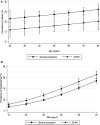Prevalence of obesity and disturbances in glucose homeostasis in HIV-infected subjects and general population - missed diagnoses of diabetes?
- PMID: 33169536
- PMCID: PMC7983891
- DOI: 10.1111/hiv.13009
Prevalence of obesity and disturbances in glucose homeostasis in HIV-infected subjects and general population - missed diagnoses of diabetes?
Abstract
Objectives: Comparative data on glucose disorders using fasting blood samples between people living with HIV (PLWH) and the general population are lacking. The objective of this study was to compare the prevalence and risk factors of obesity and disturbances in glucose homeostasis between PLWH treated with modern antiretroviral therapy and the general population.
Methods: Adjusted prevalence of obesity, features of insulin resistance (triglyceride:high-density lipoprotein cholesterol ratio and alanine aminotransferase), impaired fasting glucose (IFG), diabetes mellitus (DM) and combined dysglycaemia (presence of IFG or DM) were determined using fasting blood samples among 1041 PLWH and 7047 subjects representing the general population.
Results: People living with HIV had a lower prevalence of obesity [18.2%, 95% confidence interval (CI): 15.1-21.2 vs. 23.9%, 95% CI: 22.4-25.4], but a higher prevalence of insulin resistance and IFG (20.0%, 95% CI: 16.6-23.4 vs. 9.8%, 95% CI: 8.7-10.8) than the general population. Fasting glucose concentration was higher, but glycated haemoglobin (HbA1c) was lower, among PLWH. Prevalence of dysglycaemia for a given body mass index (BMI) was higher in PLWH than in the general population. The prevalence of DM did not differ between PLWH (13.2%, 95% CI: 10.2-15.9) and the general population (14.5%, 95% CI: 13.6-15.4).
Conclusions: The prevalence of obesity was lower, but the risk of dysglycaemia for a given BMI was significantly higher, among PLWH, highlighting the importance of prevention and treatment of obesity among HIV-infected subjects. Regardless of the increased prevalence of insulin resistance and IFG, DM was surprisingly not more common among PLWH, raising concern about the under-diagnosis of DM, possibly due to low sensitivity of HbA1c in this patient population.
Keywords: HIV; diabetes mellitus; general population; impaired fasting glucose; obesity.
© 2020 The Authors. HIV Medicine published by John Wiley & Sons Ltd on behalf of British HIV Association.
Figures

References
-
- Kahn SE, Hull RL, Utzschneider KM. Mechanisms linking obesity to insulin resistance and type 2 diabetes. Nature 2006; 444: 840–846. - PubMed
-
- Schouten J, Wit FW, Stolte IG et al. Cross‐sectional comparison of the prevalence of age‐associated comorbidities and their risk factors between hiv‐infected and uninfected individuals: the AGEhIV Cohort Study. Clin Infect Dis 2019; 59: 1787–1797. - PubMed
-
- Pelchen‐Matthews A, Ryom L, Borges ÁH et al. Aging and the evolution of comorbidities among HIV‐positive individuals in a European cohort. AIDS 2018; 32: 2405–2416. - PubMed
-
- Knudsen AD, Gelpi M, Afzal S et al. Brief Report: Prevalence of peripheral artery disease is higher in persons living with HIV compared with uninfected controls. JAIDS 2018; 79: 381–385. - PubMed
Publication types
MeSH terms
Substances
LinkOut - more resources
Full Text Sources
Medical

